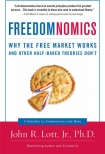Freedomnomics: Why the Free Market Works and Other Half-Baked Theories Don't John Jr. (the dot read aloud .txt) 📖

- Author: John Jr.
Book online «Freedomnomics: Why the Free Market Works and Other Half-Baked Theories Don't John Jr. (the dot read aloud .txt) 📖». Author John Jr.
Polls consistently show that the vast majority of Americans support the death penalty. A 2006 ABC News/Washington Post poll found that 65 percent of Americans favor the death penalty for convicted murderers, with 32 percent opposed.75 There is even majority support for the death penalty in such unlikely places as Brazil, Eastern Europe, Japan, and South Africa.76 A plurality in Britain also supports it.77 This should not be too surprising; as Supreme Court Justice Antonin Scalia noted, the death penalty was abolished in many countries by judicial fiat, despite widespread support for it among the general populations.78
A lot of people grasp intuitively an idea that economists only now are building a consensus toward: that the death penalty helps deter violent crimes and saves lives.
What Decreased Crime? Part II
Law Enforcement
The nation’s prison population grew 2.6 percent last year, the largest increase since 1999, according to a study by the Justice Department. The jump came despite a small decline in serious crime in 2002. . . . Alfred Blumstein, a leading criminologist at Carnegie Mellon University, said it was not illogical for the prison population to go up even when the crime rate goes down.... Professor Blumstein said...that it has become increasingly clear from statistical research that “there is no reason that the prison count and the crime rate have to be consistent.” The crime rate measures the amount of crime people are suffering from, he said, while the prison count is a measure of how severely society chooses to deal with crime, which varies from time to time [emphasis added].
—Fox Butterfield, New York Times79
Is it really surprising that the number of prisoners increased while crime rates fell?80 Apparently it is to those who disregard incentives, a group that includes many criminologists as well as writers for the New York Times. Although these observers somehow doubt that locking up more criminals can deter crime, a large number of studies indicate that the more certain the punishment, the fewer the crimes committed.81 Arrest rates of criminals are usually the single most important factor in reducing every type of crime. Sensational topics like the death penalty may get the most media attention, but it is everyday police work that really makes a neighborhood safer. Changes in the arrest rate account for around 16 to 18 percent of the drop in the murder rate.82 Conviction rates explain another 12 percent. Arrest and conviction rates have an even larger effect on other types of violent crime. And their effect on property crimes is still greater, often two or three times larger than for violent crime overall.
While boosting arrest rates indisputably increases deterrence, the evidence on longer prison sentences is less clear. The reason is simple: methodologically, it’s surprisingly difficult to measure how long criminals expect to be in prison. The actual time served is often much shorter than the official length of a criminal’s sentence. Furthermore, the time that is served varies widely, even for a single type of crime, and depends on such factors as a suspect’s criminal history and the severity of the offense. Unfortunately, this kind of data is not readily available to researchers.
Arrest and conviction rates and expected prison sentence lengths all deal with deterrence—the cost to the criminal of committing a crime. But some people commit crimes despite those threats. Obviously, locking up the most crime-prone individuals will further decrease crime by keeping habitual criminals off the streets. Indeed, putting more people in prison explains another 10 to 12 percent of the drop in crime rates.83
Simply being arrested or convicted, even without a prison sentence, carries its own substantial penalties. As we noted in Chapter Two, these reputational penalties are the worst penalties that many criminals face.
What Decreased Crime? Part III
Right-to-Carry Laws
Allowing citizens to defend themselves with guns may no longer be as controversial as the death penalty. There has been a remarkable change in attitude toward the benefits of concealed handguns over the last twenty years as thirty additional states have become right-to-carry states, bringing the total to forty by 2007. These states grant permits to people of a certain age (either eighteen or twenty-one) once they pass a criminal background check and, in some states, take a handgun training class. Of these states, Alaska, Vermont, and nearly all of Montana have no regulations at all. Eight additional states allow applicants to obtain concealed weapons permits if they can demonstrate a need for the weapon. Today, only Illinois and Wisconsin completely ban citizens from carrying concealed handguns.84
States have clearly found a societal benefit over the last few decades in expanding their citizens’ rights to carry concealed handguns. It is revealing that no state that has relaxed its rules for obtaining concealed handgun permits has reversed course and instituted new restrictions.
The impact of these permits on crimes is no trivial matter; conservatively, there are over 4 million concealed handgun permits in the United States.85 While relatively gun friendly states such as Pennsylvania and Florida have alone issued 1.1 million permits between them, even some places with strict gun regulations have a surprisingly large number of permit holders. This is certainly true for New York City (38,500) and Massachusetts (203,000).86
While concealed weapons allow people to protect themselves from criminals, there are obvious possible drawbacks to increasing the number of gun carriers. People can get hurt in accidents, or gun carriers may use their weapons irresponsibly. The main question is: do concealed handguns save more lives than they put at risk?
It is abundantly clear that legal gun owners themselves pose few risks.87 The type of person who is willing to go through





Comments (0)